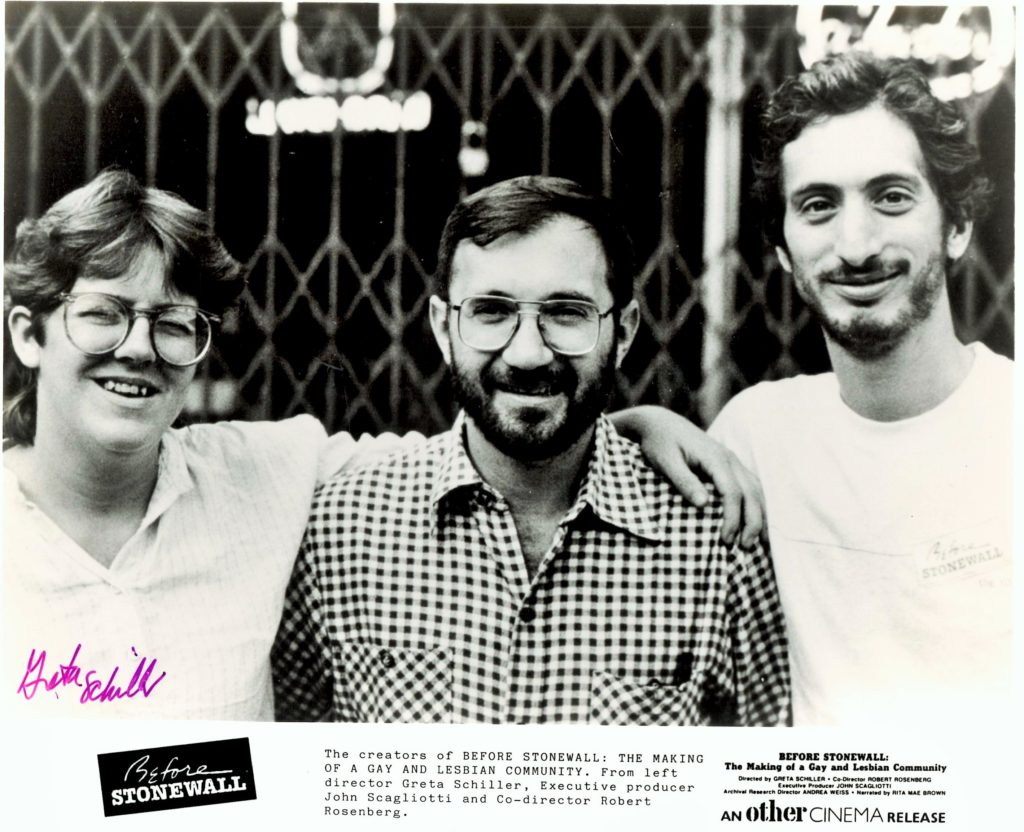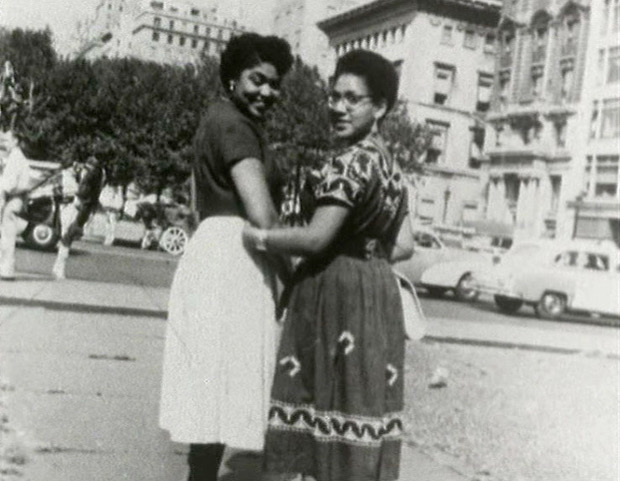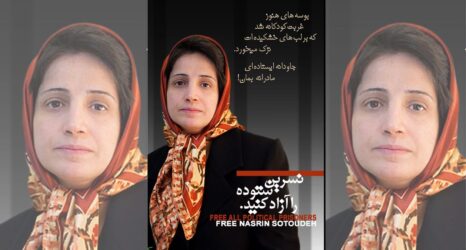It’s been 50 years this June since three days of rioting outside of New York City’s Stonewall Inn launched the modern LGBTQ rights movement—and 35 since documentary director Greta Schiller uncovered the histories of queer and trans Americans in the decades prior.
“When we set out to make this film,” Schiller has said, “I had no inkling of the meaning it would have around the world.” Indeed, she likely couldn’t have predicted what would come next: funding and support from PBS, which meant broadcasting the film nationwide into the living rooms of everyday Americans, and even an Emmy award. But Schiller’s acclaim has only grown in the years since Before Stonewall: The Making of a Gay and Lesbian Community came out.
After co-founding production company Jezebel Productions, Schiller produced a slate of notable documentaries, including the Teddy Award-winning The Man Who Drove With Mandela and Paris Was a Woman, which was broadcast around the world. She was awarded the City College of New York Townsend Harris Medal for Outstanding Contributions to her Field and a Rachel Carson Fellowship, was the first person to receive a UK/US Fulbright Arts Fellowship in Film and is currently producing a new documentary series as part of her Global Fulbright Award.
First Run Features is now re-releasing Before Stonewall—narrated by author Rita Mae Brown and featuring interviews with activists including Audre Lorde and Barbara Gittings—to mark the current historic moment. But the personal and profound stories of LGBT Americans that populate Schiller’s Emmy award-winning film remain timeless, and so does its urgent reminder of the personal and political battles facing the LGBTQ community.
In advance of the film’s theatrical re-release in New York City on June 21 and Los Angeles on June 28, Schiller opened up to Ms. about what happened before Before Stonewall—and what lessons she has carried with her since.

I always begin with an inception story. Tell us how this movie came to be—why did you decide to make it, and what did it take to make it happen?
The project began when Robert Rosenberg, who became the co-director, approached me with the idea to make a film based on the unpublished work of historian John D’Emilio—which chronicled the early, pre-Stonewall, homophile movement. Early funding came from the New York Council on the Humanities and the NY State Council on the Arts.
It became clear pretty quickly that I needed to expand the original concept to trace the formation of the mostly hidden lesbian and gay subculture across the country, not just the few homophile organizations. I decided to tell this story chronologically, decade by decade—from the turn of the century when homosexuality began to be seen as a distinctive identity, rather than simply a sex act, up to the Stonewall Riots, when marginalized gay and lesbian youth fought back against police raids and the modern LGBT movement was born.
But as the lives of homosexuals pre-Stonewall had been so marginalized, we had a big problem: How could we tell this tale in a visual and engaging way? Even when gay life spilled onto the streets of Greenwich Village—over 5 nights, hundreds of people protested—the news media gave very little coverage to the riots, and there was almost no visual documentation of gay life before then.
Rosenberg, Research Director Andrea Weiss and I were on the project from its inception. Executive Producer John Scagliotti was brought on by the Corporation for Public Broadcasting; he was a condition of our funding. Yet they did not give full funding, and in order to match their award, we all worked organizing benefits across the country.
As this was the first GLBT history feature film, we had tremendous support from the burgeoning gay and lesbian community. By drawing attention to the project, these events also helped us locate potential interviewees. Andrea organized research teams to find people who may be willing to share their personal scrapbooks. This was the first time anyone saw their personal artifacts as history. It was difficult to convince many of them that their photos, home movies and love letters were in fact worthy of being considered historical. Today, in our age of instant celebrity, people think even their pets are worthy of such.
I was inspired by UNION MAIDS, a film by Julia Reichart and Jim Klein—the first filmmakers who used oral history as history in film. The weaving of personal eyewitness testimony into the historical narrative provided a way for me to begin thinking about how to approach my task. At her retrospective screening last week at MOMA, I saw one parallel I had not seen on first viewing, and that was that communists were also closeted. Even union leaders kept their party membership secret from the public, despite the fact that their entire lives—work, love, family, play—all revolved around party membership.
We were what would now be called “artisanal” or “boutique”—most of us were doing our jobs for the first time. The sound woman J.T. Tagaki’s first sound job was interviewing Allen Ginsberg! I would film the stills on a 16mm camera while at people’s homes. I drove to Virginia with a sound recordist and had Rita Mae Brown read the narration in her living room. We carried 16mm prints to festivals to save on shipping.
It reminds me of this comment of yours—it struck me. “I was a young woman director in the early 1980’s, setting out to tell the ‘History 101’ version of a people systematically ignored and erased from the historical record,” you said. “Perhaps if I had been older, I would not have taken on the task with such naïve zeal.”
But this film ended up having an outsized impact: being the first movie on LGBTQ lives shown on public television, and winning awards for how it shaped our cultural narratives and understandings around gay life. How did that zeal shape your process, and what did it teach you as a filmmaker? What from this process have you carried into your other work?
Today I spend a fair amount of time mentoring young filmmakers. Not all of them are women or gay, but they are talented and marginalized by the media landscape. I had no real mentors; there were literally five or six women and maybe two lesbians who had made feature documentaries. Emile d’Antonio looked at some edits and gave me valuable feedback. Filmmaker Artie Bressan was super supportive, and film historian and activist Vito Russo was a good friend and invaluable guide to GLBT representations in cinema.
I grew up at a time when we actually believed we may make a revolution in this country: when women would be equal to men; when workers were paid a living wage; where health care would be universal. My friends were gay, straight, black and white, and I believe this is what gave me that zeal. My co-producers gave feedback, but Andrea Weiss was the most crucial support and critic, and she can be seriously critical in the most demanding way. When I faced obstacles from within the production team itself, she helped me maintain my zeal.
Trusting myself, the importance of holding close my vision for a film’s narrative, listening to collaborators while being confident in my directing, was a process I learned on the making of my first feature documentary. I also learned that when a film is successful, then those who had doubts and drifted from supporting my efforts come back with a roar to stake their claim—so I learned to take much stronger legal protections. When we began this process of making the film, I thought lawyers were only for when problems arise; now I know they can prevent problems down the road.
It was also a time of collectivism, so some people were given roles beyond their capacity, while others were not given the credit they deserved. My sister Tina Schiller was our San Francisco Production Manager—she organized a benefit screening of an Andy Warhol film, Edie, at the legendary Castro Cinema, and has been amazingly supportive throughout my life and career. Today, I choose my collaborators with much greater care! Making an independent film can be either a dysfunctional family unit or functional one. Coming from a dysfunctional family, I had no idea back then that there was another way. After much work on healing that original family, and having good relationships with my extended families, and being married for 35 years—legally married for one—and raising a daughter and making 15-plus films, I can look back and see that it is a sort of miracle that we pulled the film off at all!
As a director, the film gave me enormous confidence to bring stories hidden from history into the cultural zeitgeist in a way that respected my subjects. To be trusted by African American women, some of them lesbians, was and is a great honor. To collaborate in a deep, productive way with researchers, producers, writers—all of this I learned and grew better at over the years.
I have maintained friendships and in many cases professional relationships with virtually everyone who helped bring Before Stonewall to fruition. My lifelong creative partnership with Andrea began on Before Stonewall. I learned from Before Stonewall that a film has many filmmakers, but one Director, except in very exceptional cases. I co-directed The International Sweethearts of Rhythm with Andrea, but after that we each developed projects as Director, producing one another’s films through our production company. I believe we are the longest-running women’s film production company, at least in the U.S.
My sense of irony, use of music, intimate interview style, writing those who had been written out back into the historical narrative, looking at newsreels and other dominant media through a different lens, reading the subtext, drawing out a narrative that gives a fresh look at history— from the South African liberation struggle to women artists in Paris between the world wars to many other films set in other eras and cultures—this all grew from my first feature documentary. Today I am finishing a film about humans and our relationship to the earth, about ecological restoration—and even in this film, respecting the people, animals, landscapes, wanting to tell their story, comes from the same place.

What do you hope comes of the film’s re-release?
My goals are the same: to bring the story of the making of the LGBT community from a scattered, closeted people into full members of society and do it in a way that engages everyone. Gay, straight, young, old—I hope that everyone enjoys the film.
Even though the LGBTQ movement itself has evolved so much in the last 50 years, and especially since many of the moments in history you touch on that go even further back, so much in this film still resonates—the schisms within the LGBTQ community, for one, and the challenges people at the intersections face in making themselves heard—and we’re still setting records straight, even about Stonewall. What lessons from our history do you think are most critical to remember in this current moment?
One of the most important lessons is to embrace diversity.
I would like to note that we did not really want bi people in the movement back then—we considered them to be confused! Trans rights were not a political issue yet. I fought with my co-producers about opening the film with drag queens, which they saw as too controversial.
I have always adored a good drag butch or queen; the early homophile movements tried to silence drag queens. Butch women, working class lesbians and gay men and people of color were largely absent from pre-Stonewall organizations. One of our regrets is that when researcher Andrea met Marsha P. Johnson at her home in New Jersey, we did not then interview her.
What fights ahead do you feel are most pivotal?
I anticipate fights around the right to adopt or to marry—these are victories that can be reversed. Violence and homelessness, sexual abuse and suicide among GLBT youth are great concerns. A far-right religious group, Project Blitz, has begun a campaign to discriminate under the auspices of religious freedom—they want to pass bills banning government entities from penalizing people or businesses who’ve donated to or are affiliated with a religious organization, even if those groups are known to have discriminatory practices, and they have already made inroads in the Texas legislature, but for the first time an LGBT caucus exists in the Texas legislature and they have fought to keep and expand protections. Voting really matters, who sits in government matters. The bans on trans people in the military and elsewhere is the easiest and first attack.
History is not linear. While societal attitudes have shifted enormously, there will always be homophobia, and we need to stay vigilant. So much depends on where you live, if the family you grew up in accepts you, if you can get a job. Social service agencies need to provide services for the marginal members of our community.
I’m fascinated, as a queer woman myself, with the urgency and importance we have toward and reverence we owe our elders—and the relationships we have to them. So often, we don’t know who they are. Too often, we never have the chance to witness them. This film introduces us to them. How do you think LGBTQ activists and allies today can best honor them?
I think respect for seniors is a problem everywhere. Cross-generational interaction is nearly non-existent. People push past older people on sidewalks, trains, buses—and many of them are no doubt members of the GLBT community. SAGE hosts intergenerational dinners and events designed to encourage more exchange of ideas and perspectives.
It is very hard for a young person to imagine anything outside of their own experience as valuable, impossible to imagine that simply loving someone of the same sex until the 1970’s was a brave act, punishable under the law of the land in counties ways. I hope seeing my film will help with this, at least a little.





